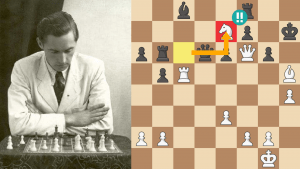
Readers’ Games, Questions and Comments, Part 6
Million Dollar Fantasy
QUESTION 1:
Chess.com member Einet890 asked: “If you were to train me for two years to become a GM and had a million dollars on the line, what would the training look like?”
ANSWER:
This kind of question can easily spawn similar nonsense questions like “If I saw you on the freeway and purposely hit your car 'cause you didn’t agree to teach me, would you cave and give me lessons once you got out of the hospital?”
I’ll answer Einet890’s question, but in the future I’ll pass on fantasy queries.
To give Einet890’s question the respect it deserves, I first need to mention the great Henry Whipps Wallenborg (according to various sites, his peak rating was 2680 in 1887), also known as the Alabama Anaconda due to his “squeeze you to death” style.
You might wonder why his middle name was “Whipps.” The story goes that an enemy of Wallenborg’s named Albert (he was around 2350 strength) made a sizable bet that he could beat any player of low master strength in an 8-game match after Wallenborg trained him for 1.5 years. Wallenborg jumped on this bet, and they agreed to the aforementioned time frame.
After searching for a suitable candidate, Wallenborg found a young man (David) that was delighted to get lessons from such a legendary player. What poor David didn’t realize was that this bet meant a lot to Wallenborg. (Both his ego and serious money was at stake!) Thus it was that Wallenborg had David sign a contract that stated, for the next 1.5 years, he would have to obey his new teacher completely. (Wallenborg would pay all his living expenses during that period.)
The training was brutal! Whenever David failed to take his studies seriously, or lost concentration, Wallenborg would beat him with a long leather whip without mercy. In fact, these beatings were so common that another whip had to be purchased since the original one fell apart from overuse!
I’ll leave out the rest of the story. You can look it up in the history books. But after the whole affair was over, Wallenborg was given the nickname "Whipps" (for obvious reasons).
I bring this tale up to illustrate what would happen if I were somehow forced into a million-dollar bet. Rest assured that I would turn medieval on you. I would own you body and soul for the first year of pure training, and any nonsense would not be punished by whip, but rather with a Taser. (After all, we’re civilized nowadays.)
Hmmm… right now my nickname is the Los Angeles Eclectic, but after zapping you endlessly with the Taser, my nickname would have to be changed to the Los Angeles Electric.
However, since people are no longer allowed to own other people I wouldn’t accept that wager. (You could simply walk away when the going got too hard, leaving me a million bucks in the hole.)
What are Better, Bishops or Knights?
QUESTION 2:
Chess.com member PeterB1517 asked: “In early lessons of Chess Mentor, it says that knights and bishops are equal. I think you revise that later on, but it is misleading.”
ANSWER:
I wrote most of my chess mentor stuff a lifetime ago. In fact, the latest material I did for chess mentor also seems like it was long, long ago. What I’m saying is that I don’t remember anything I wrote in those modules. Nada!
However, the “what are better, bishops or knights” question is an important one with several possible answers. I’ll say this: Knights are trickier than bishops so, in a majority of cases in amateur games the knight will give you the best return for your buck.

Bishop Knight Glass Chess Pieces 8-26-09 by Steven Depolo
At the highest levels the bishop is preferred, though there are exceptions. (Petrosian and Larsen were big knight fans.) But preference doesn’t mean much in IM and GM games since we always go with the piece that’s best suited for the position on the board -- pawns structure, closed vs. open positions, specific tactical considerations, whether or not the knight has an advanced, juicy square to live on (or whether or not you can create one), etc.
Personally (yep, here comes preference!), I have a thing for knights, but love doesn’t stop me from being coldhearted and going with whatever piece offers me the best chance at winning the game. And this takes us back to the position on the board and the harsh realities that the position offers!
Breaking Down a Position
QUESTION 3:
Chess.com member Numquam (referring to Test Your Chess Understanding, Part 3) said: “In puzzle one 26...Qxe5 after 25...c5 26.dxc5 is a terrible move. Black should play 26...Rd8 and I am not sure if White can win that.”
ANSWER:
Your question is a very good one... errrr... actually, it wasn’t a question, it was a statement. Other than the fact that you didn’t say which rook should go to d8, I have to disagree with your assessment. (No analysis, no explanation, just a voice from the heavens declaring he is right.)
I don’t think 26.dxc5 is a terrible move at all, but I am impressed by your argument (giving up a second pawn to create a blockade), which has a lot of logic to it.
Here’s the position (and the moves given by Numquam) where I mentioned the possibility of 26...c5.
Since most readers don’t want to look at a long analysis of a position that has no meaning to them, I will add (before we look at some moves) an instructive bit about how I go about looking at this kind of position.

The Three Kinds of Positions:
In my view, while playing a tournament game (clock ticking, opponent glaring malevolently at you) there are three kinds of positions, each of which demands a different approach:
- The move is obvious. (You’ve already worked things out earlier, or the move is forced, or it’s obvious because the position’s pattern is well known to you.)
- It’s a tactical maelstrom, which means calculation and more calculation.
- It’s a tough position that needs to be deeply understood before you play any moves or do any analysis.
For me, this third situation is what chess is all about. (That’s right...not tactics, not positional play, not opening memorization. Instead it’s all about exploration and discovery!) Though a professional will usually break a position down quickly (helped by the abundance of patterns he’s acquired during his career), amateurs have a much harder time doing this during an actual game and usually just look for moves.
For those lucky enough to have a chess teacher, before giving him your games to analyze, it would be wise to break down the key position in each game so your teacher can see what you do and don’t understand (thereby helping him fix your chess ills).
Breaking down a position is easy. (Getting it right isn’t!) You root out the position’s nuts and bolts (basics), you figure out your opponent’s plusses/negatives, and you figure out your plusses/negatives. Once you grasp those things, you then formulate a plan and/or move that caters to the position’s needs.
The Position’s Nuts And Bolts:
- White is two pawns up.
- The queenside is no longer a safe place for Black’s king.
- White enjoys a central and queenside space advantage.
- Black has an iron grip on the light squares.
- Black’s king isn’t particularly safe on the kingside either.
- Black is striving to draw.
Black’s Ideas:
- Black has a firm block on White’s e5-pawn, which in turn blocks White’s bishop.
- Black is trying to draw by holding the blockade and depriving White of a way to break through.
- At some point, Black can get counterplay by creating a passed a-pawn via …b5-b4 (sacrificing a third pawn!).
White’s Ideas:
- Since White’s two pawns up, he can (in some lines) sacrifice one or both of them without being down material (a well-timed c5-c6 or e5-e6 can be deadly if the Queen is pulled off of e6) to free his Bishop and clobber Black’s king.
- White would love to stick a rook(s) on the d-file, move his Bishop off of d4, and cram a rook into d6.
- Black’s queen is stuck on e6 since moving it allows e5-e6 freeing White’s bishop. Having the enemy queen passively stuck like that gives White free rein to try all sorts of plans.
- Even if White sacrifices his e-pawn but Black manages to trade all the rooks, White will still have a winning advantage due to the extra passed c-pawn and the very vulnerable position of Black’s king. (The kingside dark squares are owned by White.)
- White will maneuver his queen to g5 or h6 in preparation for a kingside attack.
- Black is completely passive, so there’s no need to hurry. Before going for the kill, White should place all his pieces on their ideal squares.
- In an actual game, I would first assimilate all this information (info first, analysis second), which would make me feel confident that it was winning. Then and only then would I analyze the best way to accomplish my goals.
- Since a forcing analysis would take too much time (yes, I actually do other things than write for Chess.com), I’ll just give a few lines that demonstrate White’s possibilities. (Don’t expect perfect play, this is just a very limited demo.)
There are all sorts of other lines, but when all is said and done, Black has to be completely busted after 25...c5 26.dxc5.
RELATED STUDY MATERIAL
- Read IM Silman's previous article: Riding the Winds of Fashion, Part 3.
- Watch IM Daniel Rensch's video on how to evaluate a position with a material imbalance.
- Learn how to block his plan, and build yours in the Chess Mentor.
- Sharpen your tactics with the Tactics Trainer.
- Looking for articles with deeper analysis? Try our magazine: The Master's Bulletin.







